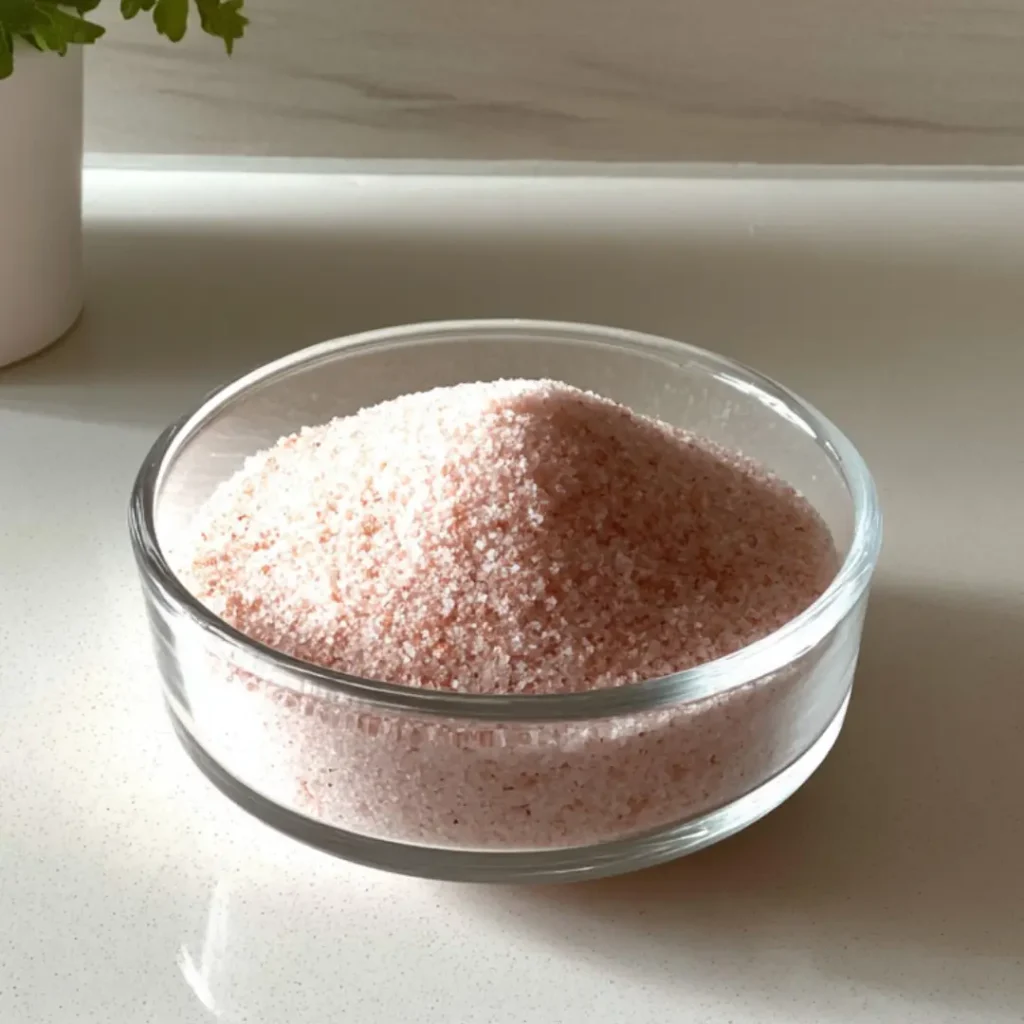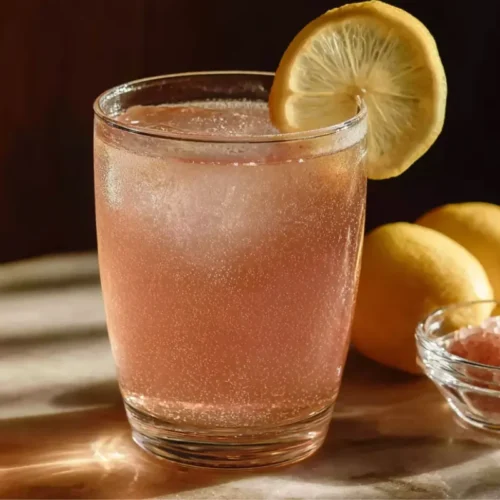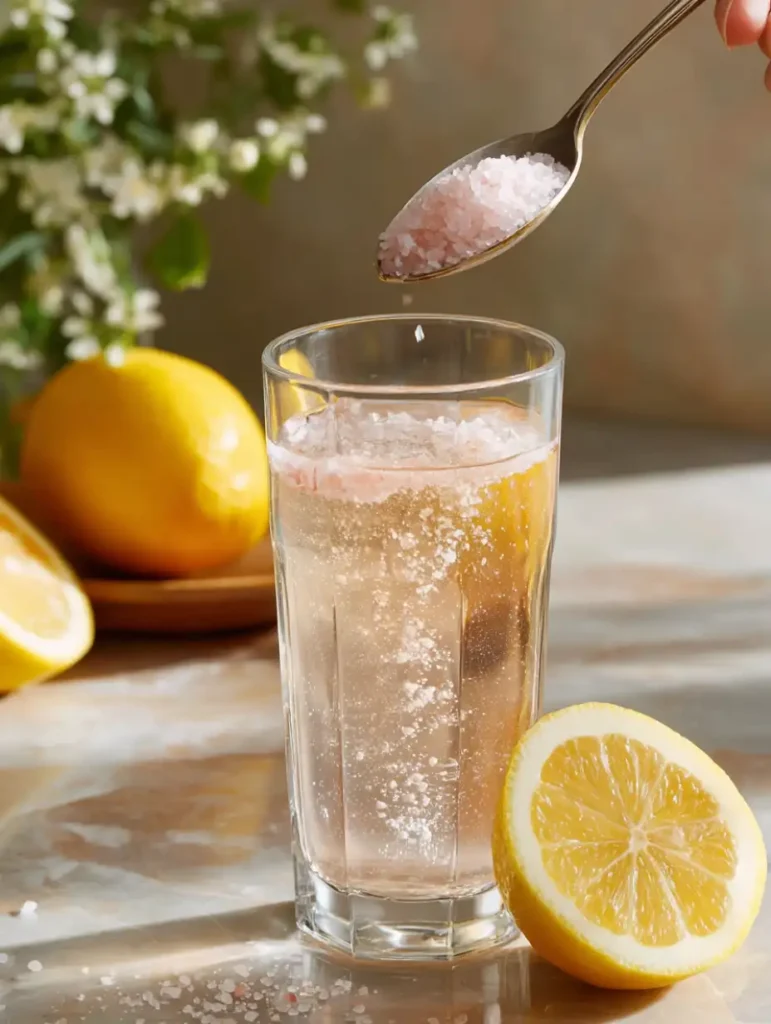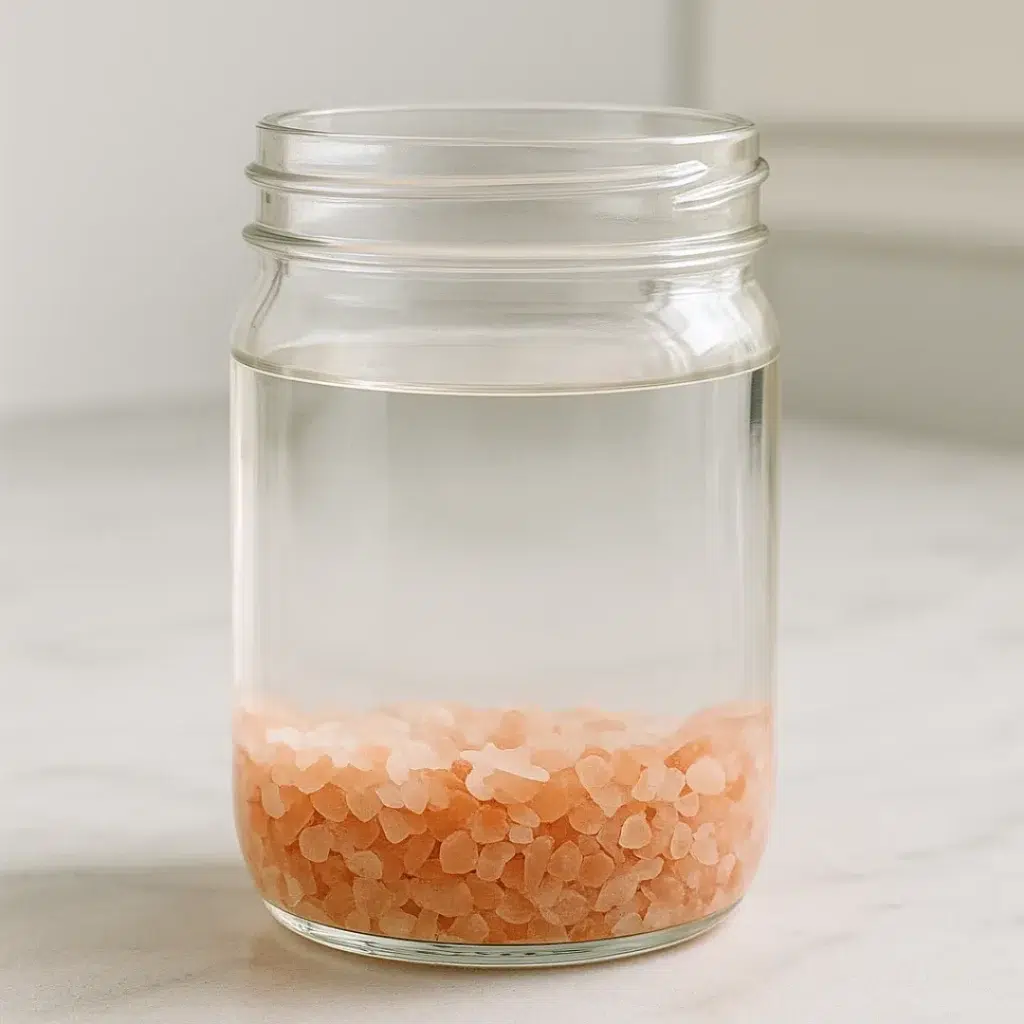Pink Himalayan salt water might not sound glamorous, but it’s become one of the most talked-about morning rituals online. From TikTok reels to recipe blogs, the “pink salt trick” is being praised as a simple drink that may support hydration and, for some people, weight management.
If you’ve seen claims that it “melts fat overnight,” let’s clear that up right away, it doesn’t. What this recipe actually offers is a refreshing way to boost fluid intake, keep electrolytes in balance, and set a steady routine. In this guide, you’ll learn exactly how to make the drink, when to use it, what variations exist, and most importantly, how to keep it safe.
What Is the Pink Salt Trick?

The pink salt trick is a simple drink made by mixing a small pinch of Himalayan pink salt with water. Some people add lemon juice or apple cider vinegar, but the base version is just salt and water. It’s often sipped first thing in the morning or before workouts as a way to replace fluids and minerals.
This isn’t a magic potion for fat loss, but it can help with hydration, reducing bloating, and supporting steady energy when used as part of a balanced lifestyle.
Safe Range and Sodium at a Glance
To keep this habit safe, you need to measure carefully. Here’s a quick guide:
| Pink Salt | Approx. Sodium | In 8–12 oz of Water |
| ⅛ teaspoon | ~290 mg sodium | Mild taste, light saltiness |
| ¼ teaspoon | ~580 mg sodium | Stronger taste, more noticeable |
💡 Most people stick to ⅛–¼ teaspoon per glass. That’s enough to get the hydration benefits without overdoing daily sodium.
__________________________________

Pink Salt Trick Recipe for Weight Loss
Equipment
- Glass
- Spoon
- Measuring spoons
- Jar with lid (for sole method)
Ingredients
Classic Pink Salt Trick
- 1/2–1 teaspoon Himalayan pink salt (fine or coarse) See safety range: 1/8–1/4 tsp per glass
- 8–12 oz Filtered water
Optional Add-Ins
- Fresh lemon juice (squeeze) Optional
- 1 teaspoon Apple cider vinegar Optional
- 1/2 teaspoon Honey Optional, for sweetness
- 1 pinch Cayenne pepper Optional
- 1 slice Fresh ginger Optional
Sole Water (Optional Concentrate)
- Himalayan pink salt (to fill jar 1/4 full) For making sole concentrate
- Filtered water (to cover salt) For making sole concentrate
Instructions
- Add Himalayan pink salt to a glass with 8–12 oz filtered water. Stir until fully dissolved.
- Optional: Mix in a squeeze of fresh lemon juice or 1 teaspoon apple cider vinegar. Add a small drizzle of honey for taste if desired.
- Sip slowly, ideally first thing in the morning or before a workout.
- Start small if you’re new: 1/8–1/4 teaspoon salt per glass is a commonly used safe range.
- Sole concentrate (optional): Fill a glass jar 1/4 with pink salt and cover with filtered water. Seal and rest overnight until some salt remains undissolved.
- To use sole, add only 1 teaspoon of the concentrate to 8–12 oz water. Never drink sole straight from the jar.
- Timing ideas: morning for rehydration, pre‑workout to support electrolytes, or light evening use to reduce leg cramps.
- 7‑day gentle routine: Days 1–2 use 1/8 tsp once daily; Days 3–5 increase to 1/4 tsp if taste is fine; Days 6–7 add a second glass pre‑workout if needed.
- Safety: Limit to one small glass per day for most healthy adults. Avoid if you have high blood pressure, kidney disease, or are on sodium‑affecting medications.
Notes
Nutrition
Does the Pink Salt Trick Help with Weight Loss?
The short answer: it may support your routine, but it won’t directly burn fat. Pink salt water works best as a hydration habit that helps you stay consistent with healthy choices; if you want a simple alternative to test, try the Natural Zepbound recipe. Many people mistake its effects, like reduced bloating or better digestion, for weight loss, but that’s more about water balance than body fat.
The Science in Plain Terms (Hydration, Electrolytes, and Energy)
- Hydration: Staying hydrated helps the body work smoothly. Water alone is great, but adding a pinch of salt can help the body hold onto fluids a little longer.
- Electrolytes: Pink salt provides sodium, which the body needs for muscle contractions and nerve signals. When paired with enough water, it can help reduce fatigue and cramping.
- Energy use: Staying hydrated helps metabolism work smoothly. It won’t “speed it up,” but it keeps your body from slowing down due to dehydration.
Myth vs Fact
- Myth: Pink salt melts belly fat.
- Fact: It helps you stay hydrated, which can reduce water retention and help you feel less bloated.
- Myth: It detoxes your body.
- Fact: Your kidneys and liver handle detox. Salt water can only support hydration, not replace organ function.
- Myth: More salt = more benefits.
- Fact: Too much sodium can raise health risks, so small amounts are key.
A Dietitian’s Take
Nutrition experts often remind people that salt water is not a miracle. It can be a handy morning ritual, but results come from overall lifestyle, balanced food choices, regular movement, and good sleep. A dietitian would likely frame it as a hydration helper, not a standalone weight-loss tool.
How to Make the Pink Salt Trick Recipe

This is the part most people come for, the actual recipe. It’s quick, simple, and easy to adjust. Below you’ll find the classic version plus a few popular twists; if you prefer a colorful morning sip, this blue spirulina smoothie is a fun swap on rest days.
The Classic 3-Ingredient Recipe
Ingredients:
- ½–1 teaspoon pink Himalayan salt (fine or coarse)
- 8–12 oz filtered water
- Optional: squeeze of lemon juice or 1 teaspoon apple cider vinegar
- Optional: a small drizzle of honey for taste
Steps:
- Add the salt to your glass of water. Stir until dissolved.
- Mix in lemon juice or apple cider vinegar if you like extra flavor.
- Sip slowly, ideally first thing in the morning.
Nutrition (approximate):
- ½ tsp = ~290 mg sodium
- 1 tsp = ~580 mg sodium
- Calories: 0 (unless honey is added)
Popular Variations and Add-Ins
| Variation | Add-In | Why People Use It |
| Lemon | Fresh juice | Bright flavor, vitamin C |
| Apple cider vinegar | 1 tsp | Claimed digestion support |
| Honey | ½ tsp | Natural sweetness, smoother taste |
| Cayenne pepper | Pinch | Warm kick, linked to metabolism |
| Ginger | Fresh slice | Spicy flavor, calming for stomach |
Sole Water Method (Concentrate, Read Before Mixing)

Sole is a concentrated mix of pink salt and water. Some prefer it because it’s easy to keep in a jar and scoop daily.
How to make sole:
- Fill a glass jar ¼ full with pink Himalayan salt.
- Pour filtered water until the salt is fully covered.
- Seal and let sit overnight.
- When a layer of salt remains at the bottom, the mix is ready.
How to drink it safely:
- Add just 1 teaspoon of sole to 8–12 oz of water.
- Never drink sole straight from the jar, it’s far too strong and unsafe that way.
Fasting and Timing
One of the most common questions about the pink salt trick is whether it fits into fasting plans and when the best time is to drink it. Here’s how it breaks down.
Will This Break a Fast? Strict vs Flexible Rules
- Strict fasting: If you’re aiming for zero calories and no triggers to digestion, plain water is the only safe choice. Even a pinch of salt technically counts as “breaking” a strict fast. For strict plans that allow only plain water, tea, or coffee, see this overview from Harvard Health.
- Flexible fasting: Many people doing intermittent fasting use small amounts of electrolytes to get through long stretches without food. In this case, pink salt water can fit, especially if you keep it plain (no lemon, no honey).
- With add-ins: Lemon juice, apple cider vinegar, or honey all add calories and will end a strict fast. For flexible fasting, some people still allow them, but it depends on your goals.
Best Time to Drink It
- Morning: Most common choice. It helps kick-start hydration after hours of sleep.
- Pre-workout: A small glass can replace lost electrolytes and may reduce cramps; for steady carbs, bake a batch of banana oatmeal muffins to grab before the gym.
- Evening: Some prefer sipping it before bed to reduce night-time leg cramps, but keep it light, too much sodium late in the day isn’t ideal.
A Gentle 7-Day Routine
Here’s a simple way to test the pink salt trick without overdoing it:
- Day 1–2: ⅛ tsp in 8 oz water, once in the morning.
- Day 3–5: Increase to ¼ tsp if taste is fine, still once daily.
- Day 6–7: Try a second glass before workout or mid-afternoon if needed.
After the week, check how you feel; on mornings you sip the drink, a pan of baked cottage cheese eggs gives you simple protein without heavy prep. If it helps hydration and fits your lifestyle, keep it as an occasional habit rather than an all-day drink.
Safety Notes and Side Effects
Pink salt water may look harmless, but too much sodium can create problems. A small daily glass is fine for many healthy adults, but it’s not for everyone.
Who Should Skip This Drink
Avoid or limit the pink salt trick if you:
- Have high blood pressure or are on medication for it
- Live with kidney disease or other conditions where sodium is restricted
- Are pregnant or breastfeeding without a doctor’s approval
- Take water pills or other medications that affect sodium balance
⚠️ When in doubt, check with a healthcare professional before adding it to your daily routine. People with high blood pressure or chronic kidney disease are often advised to limit sodium; guidance from the American Heart Association and the National Kidney Foundation explains why tighter targets can help.
Daily Sodium Basics
In the United States, the recommended sodium limit is about 2,300 mg per day for adults, see the CDC. Some groups (like those with hypertension) are advised to stay closer to 1,500 mg, the American Heart Association sets that as a better goal for many adults.
- ⅛ teaspoon pink salt: ~290 mg sodium
- ¼ teaspoon pink salt: ~580 mg sodium
- 1 teaspoon pink salt: ~2,300 mg sodium, which equals the full daily limit for most adults, per the National Kidney Foundation.
This is why keeping servings small is so important. Think of it as a hydration helper, not a free pass to load up on salt.
The “Oprah” and “Japanese” Pink Salt Trends Explained
Like most viral health hacks, the pink salt trick has been tied to celebrities and catchy names. Two of the biggest are the “Oprah Pink Salt Recipe” and the “Japanese Pink Salt Trick.“
Oprah Pink Salt Recipe What’s Real
Some sites claim Oprah promoted the pink salt trick as part of her routine. In reality, there’s no evidence she created or endorsed the recipe. The link comes mostly from online chatter and spin-off posts.
- What you should know: Oprah didn’t invent this recipe. If you see her name attached, it’s marketing, not fact.
Japanese Pink Salt Trick vs the Classic Recipe
The so-called “Japanese” version usually uses the same base drink, water plus pink salt, but with small twists like:
- Serving it iced
- Adding a squeeze of lemon
- Sometimes mixing it with green tea
The idea is that it feels lighter and refreshing, but nutritionally it’s no different from the classic recipe. If you want to try it, just keep the salt amount the same (⅛–¼ tsp per glass); for another Japanese‑style trend, see the Japanese Mounjaro recipe.
Conclusion
The pink salt trick isn’t a magic fat-burner, but it can be a simple way to stay hydrated and keep electrolytes balanced. A small glass in the morning or before a workout may help you feel less bloated and more energized, as long as you keep the salt within safe limits.
Think of this recipe as a gentle routine, one that supports your day, not one that replaces healthy eating or movement. If you try it, start small, listen to your body, and remember that balance matters more than quick fixes.
FAQs
1. What is the pink salt trick recipe for weight loss?
It’s a drink made by mixing ⅛–¼ teaspoon of Himalayan pink salt with 8–12 oz of water. Some people add lemon juice or apple cider vinegar for taste.
2. Does the pink salt trick actually work?
It doesn’t burn fat directly. Instead, it helps with hydration and may reduce bloating, which can support a weight management routine.
3. How much pink salt should I put in 8 or 12 oz of water?
Most people use ⅛–¼ teaspoon per glass. That gives you 290–580 mg of sodium, which is within a safe daily range if you only drink one serving.
4. Will pink salt water break an intermittent fast?
Yes, under strict fasting rules even a pinch of salt breaks a fast. Under flexible fasting, plain salt water is often allowed, but lemon, ACV, or honey will end the fast.
5. Is it safe to drink pink salt water every day?
For many healthy adults, one small glass per day is fine. But too much salt can be harmful, so keep it limited and avoid it if you have high blood pressure or kidney issues.
6. Who should avoid the pink salt trick?
People with high blood pressure, kidney disease, or anyone on medication that affects sodium balance should skip it unless a doctor says otherwise.
7. Can I use regular table salt instead of Himalayan pink salt?
Yes, you can. Both are mostly sodium chloride. The difference is mainly trace minerals and taste. Pink salt is often chosen for its mild flavor and trend appeal.









